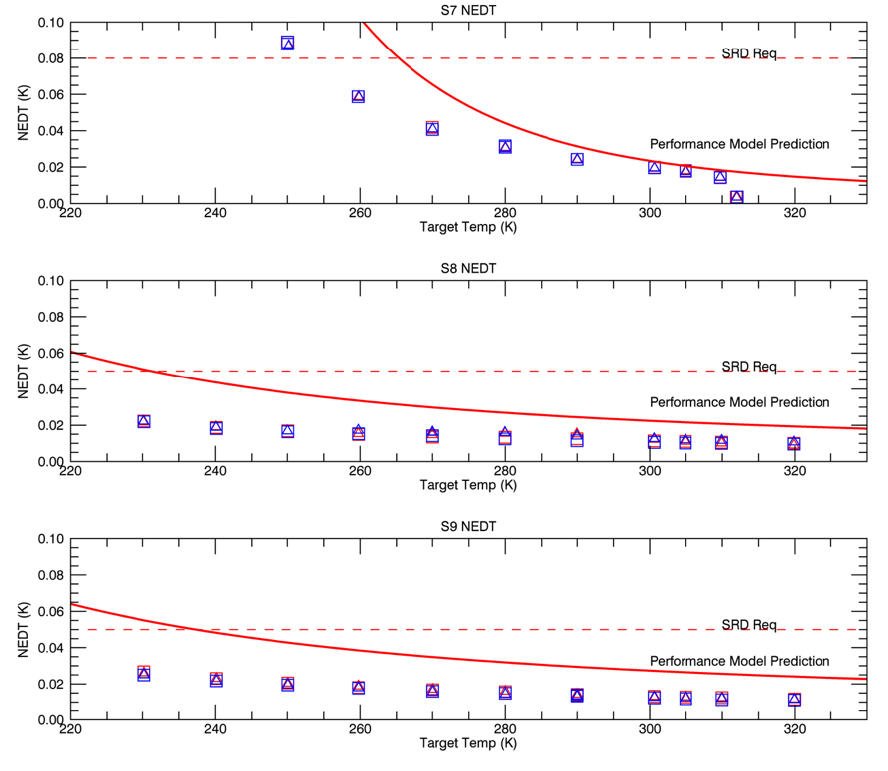24 February 2023
08 October 2019
The study had two main aims: to develop and provide a tool for deriving per pixel level-1 uncertainties for Copernicus Sentinel-3 SLSTR data, and secondly to implement Level-1/0 monitoring at EUMETSAT.
A python tool has been developed to derive estimates of pixel level uncertainties. New functionalities include an updated uncertainty model and the availability of further pre-launch measurement data. The tool is now available for users to utilise within their own level-2 processing chains and applications to derive per pixel uncertainties for geophysical retrievals (such as Sea Surface Temperature and other level-2 products). The capability is available for further SLSTR level-2 evolutions and processing chains. Future work may include further updates to the uncertainty model and discussions of the potential inclusion of the tool algorithm in operational processors.
The second part of the study developed and implemented Level-1/0 monitoring at EUMETSAT. The monitoring runs within the EUMETSAT cal/val infrastructure and provides routine time-series to plot and monitor instrument long-term orbital trends for SLSTR level-0/1 data. The tool is scalable and flexible so that further analysis of future SLSTR instruments can be added when required.
Objectives
This project documented the radiometric calibration uncertainty model for SLSTR, devised an update for the Level-1 processor providing pixel level noise and uncertainties, and supplied a prototype monitoring system for Level-1-0 data. This project is important as it enables users to derive crucial information about the uncertainties in the radiometric calibration of the SLSTR Level-1 data, that are otherwise not easily available to non-expert users.
The project had two main objectives:
Objective A: SLSTR thermal infrared uncertainties
- Documentation of the calibration uncertainty model.
- Development of a Look Up Table to include further pre-launch calibration data.
- Preparation of ATBD, IODD, DPM and Auxiliary Data File (ADF).
- Development of a Python tool for driving pixel level uncertainties from updated LUT/ADF.
- Preparation of documentation/user guide to accompany the python tool.
Objective B: SLSTR Level-0 and Level-1 monitoring
- Development of monitoring software to plot long-term orbital trends for SLSTR Level-0/1.
- Extraction of all SLSTR Level-0, Level-1 and auxiliary data needed.
- Preparation of software to collocate Level-0 and Level-1 data and documentation.
- Implementation of monitoring software for SLSTR-A/B in the EUMETSAT cal/val infrastructure, and to be scaleable and flexible for future SLSTR missions.
Overview
The initial SLSTR Level-1 products included netCDF files with per scan uncertainties provided for both infrared (IR) and visible/short-wave infrared (VIS/SWIR) channels, separately for nadir and oblique views. The products also include a look-up table (LUT) of uncertainties versus scene temperature.
Therefore, sufficient information existed for an expert user to derive a Level-1 uncertainty for each pixel, either for Level-1 applications or for including in Level-2 uncertainty modelling, such as Sea Surface Temperature products. However, prior to this study, the methodology had not been documented, and not all pre-launch calibration data that could be used to derive the uncertainties was available to users (or further level-2 processors and applications).
This study documented the uncertainty model for SLSTR Level-1 uncertainties, and further developed the algorithm and methodology, so that uncertainty estimates can be derived using a combination of information contained in the Level-1 product (e.g. noise, temperature) and a-priori (type-B) information from the pre-launch calibration.
As a result, further pre-launch measurement data were introduced within a LUT, to include dependency against noise equivalent differential temperature/radiance (NEDT/L). Figure 1 shows the variation of NEΔT versus temperature for all TIR channels.
A tool, written in python, has been developed to derive estimates of pixel level uncertainties, given the updated uncertainty model and additional pre-launch experiment information. These Level-1 uncertainties can then be utilised by Level-2 processing chains to estimate improved Sea Surface Temperature uncertainties (and other Level-2 products) at pixel level.
The Level 1-0 monitoring of SLSTR instrument performance (including temperatures, noise and mechanism stability) is important for instrument experts and expert users.
To support the analysis of L1/L2 products, monitoring tools have been installed at EUMETSAT and have been extended to include interactive plotting to allow easy trend analysis of SLSTR data. This provides an accessible and useful way to monitor key instrument performance parameters.
The outcomes of this study are the capability for users and further level-2 applications / processors to derive per pixel level-1 uncertainties from SLSTR. For example, these can be then used to derive per pixel uncertainties on SLSTR level-2 and geophysical products such as Sea Surface Temperature. Future work involves defining a way-forward for continuation of the developments, including whether the capability should be incorporated into the operational processors at level-1.
The study also gives EUMETSAT the capability to monitor the long term SLSTR instrument data orbital trends in quasi near real time to ensure operational quality of the user products is maintained. Future work could include an evolution to utilise the outputs and extracts of the L0 monitoring as input to improved uncertainty estimation.




